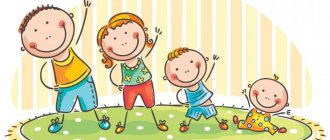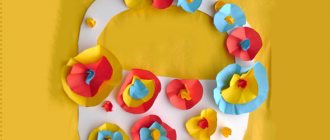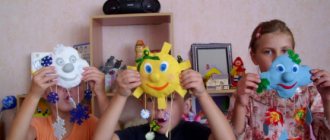Goals and objectives of breathing exercises for younger preschoolers
Breathing exercises are a set of exercises aimed at developing the respiratory system and articulation. At 2-3 years old, children often breathe through their mouths. This is facilitated by regular runny noses and problems with the adenoids, which adversely affects the tonsils, especially in the cold season.
To avoid serious consequences, according to the program developed on the basis of the Federal State Educational Standards of preschool educational institutions, the following goals are set:
- developing the skill of breathing through the nose;
- prevention of influenza and ARVI;
- increased tone of the respiratory muscles;
- positive impact on performance;
- development of organs of articulation;
- formation of concepts about healthy lifestyle;
To meet the goals, clearly defined tasks are needed:
- development of respiratory control skills: control of the rhythm, depth and force of inhalation and exhalation;
- development of speech organs through breathing exercises with pronunciation of sounds;
- filling the body with oxygen;
- respiratory muscle training;
- prevention of the formation of adenoids, rhinitis, sinusitis;
- prevention of hypothermia of the respiratory system;
- developing teamwork skills.
On a note! Mastering goals and objectives will protect the child’s body from serious and chronic diseases.
Types and techniques of conducting breathing exercises in junior groups of preschool educational institutions
Breathing exercises for younger preschoolers consist of the following types:
- With pronunciation of sounds.
- No pronunciation of sounds.
- Respiratory training through deflating light objects.
When conducting exercises to develop breathing, the following methods are used:
Speech techniques
A three-year-old baby speaks unclearly due to poor development of the respiratory system and articulatory apparatus. The use of a verbal technique allows you to “draw” an image of the task technique in your mind and reproduce it verbally. This is how breathing and speech are trained and imaginative thinking develops.
On a note! Children not only repeat after adults, but also adopt actions from their peers. This has a positive effect on the development of collective communication and group work skills. Poems, riddles and fairy tales attract a lot of attention.
Visual techniques
The first junior group is taught with regular use of visual aids. At this age they are restless, and therefore it is almost impossible to convey any information without illustration.
The use of visual breathing exercises promotes rapid assimilation of information. An object or action is stored in memory that the child will be able to repeat in the future. For example: “remember how we made a snowstorm in a bottle? And who can show how we did it?” Accordingly, children will begin to “cause a storm” without resorting to auxiliary means.
Practical techniques
A practical technique is more like a way to consolidate acquired knowledge. Children are given the task of drawing a picture, making an applique or painting an object that corresponds to the theme of gymnastics. For example, the children completed the “breeze” exercise, and the teacher gave a creative task to make an applique “the wind blows on a tree.”
Safety precautions
Any, even the most useful things, can become harmful if not observed in moderation. Below are recommendations for the timing of breathing exercises or the approximate number of repetitions. But since all children are different, differing in their psychophysical characteristics, it is never enough to simply follow the instructions.
The main thing is that in no case should you force a child or force him to do exercises through “I can’t.”
This will not only discourage the baby from any desire for further activities, but can also harm his health. Even if you seem to have just started, but the child refuses to do the proposed exercise, do not insist. Try moving on to something else or postpone classes altogether if none of the exercises “work.”
Of course, this could just be a whim. A sensitive parent or educator will be able to determine what the problem is based on the specific situation. I just want to warn you that in the case of breathing exercises, any coercion or forcing is fraught, and a child’s refusal may be associated with some kind of physical problem, discomfort, which he cannot express or even understand.
Meanwhile, the rule is valid for both children and adults: all breathing exercises are performed only in an absolutely comfortable mode.
You can also encounter the opposite problem: when a child, having played too much, does not notice the discomfort and “excess.” Therefore, the adult’s task is to monitor external signs of the baby’s well-being. Pay close attention to the color of his face. If you become pale or severely red, it is better to stop exercising.
Moderate blush is a healthy natural effect and should not be intimidating. Some increased breathing is also normal, but you need to make sure that it is not excessive, take breaks, and alternate more active activities with calmer ones. If your child complains of dizziness, you should also pause and wait until it stops. Usually this happens quite quickly. Moderate dizziness, which soon subsides, is also a reaction within normal limits.
All of the above fully applies to those groups of children for whom breathing exercises are usually considered contraindicated: children with disorders of the cervical spine and some other health problems. None of these are actually contraindications. But classes with such children require special care, and it is better to entrust them to specialists.
Sets of breathing exercises for the first junior group
There are various sets of breathing exercises for children.
Methodology for conducting breathing exercises for the first junior group
The basis of such gymnastics is the lengthening of vowels or consonants as you exhale.
On a note! In order for the kids to understand the task correctly and want to complete it, it is enough to read the riddle in poetic form or ask them to show “how the plane hums.” In this case, the teacher needs to demonstrate the action that he asks the children to perform.
When planning a complex of breathing exercises, teachers turn to breathing exercises techniques:
- Tolkachev B.S. developed methodological manuals for the rehabilitation of children after suffering from respiratory diseases.
- Buteyko K.P. specializes in oxygenating cells by applying sound vibration through the pronunciation of sounds.
- Lazareva M.L. offers a method of mastering through statistical exercises.
Children's gymnastics is carried out only if a number of conditions are met:
- use of dynamic (moving, game) exercises. Two- to three-year-old children find it difficult to follow commands to hold their breath or freeze in one position. Therefore, statistical tasks will not capture attention and the desire to act;
- the room where gymnastics is performed must be ventilated. In the summer, the windows in the room are always open, and in the winter, only short-term ventilation is possible when children are away;
- temperature no more than 20 degrees;
- classes are held an hour after meals;
- classes are held 3 times a week;
- it takes 5-7 minutes to complete the exercises;
- the complex consists of no more than three exercises repeated up to three times (the first complex goes in order, the repetition order can be changed);
- load distribution is uniform, with a gradual increase in quantity;
- If a child feels unwell (pallor, disorientation, rapid breathing), it is necessary to stop the activity.
Card file of breathing exercises in the first junior group
Card 1
- "Bubbles."
Inhale through the nose, exhale through the mouth, “blowing a bubble.”
- "How the pump works."
Hands on the belt. Inhale - half-squat, exhale - straighten.
- "Talk".
– Our train greeted us – “tu-tu” (hands perform circular movements at waist level, inhale through the nose, make a sound as you exhale)
- And the car responded with “beep” (hands in front of you “turn the steering wheel”)
– A snake crawled past – “sssss” (hands up – inhale, as you exhale they begin to wriggle and make a sound)
- A dragonfly meets her - “z-z-z” (they wave their hands at head level).
- These are such miracles!
Card 2
- "Let's chase away the rain."
GCD on sound culture of speech in the preparatory group
Children approach an object where a shiny rain hangs and begin to blow on it.
- "Swing for a toy."
They lie down on the mat with a light toy on their stomach.
– up (inhale through the nose, pull in the stomach)
– down (exhale through the nose, inflate the stomach).
- "The tree is shaking."
Sit down, back straight. Inhale - arms up, exhale - swaying, lower down.
How to do breathing exercises correctly
The first important condition is fresh air. It is best to conduct classes in nature. If this is not possible, make sure that the room is well ventilated.
The second condition can be conditionally called “empty stomach”. It may not be completely empty, of course. But it is strictly not recommended to exercise immediately after a meal, but before a meal is a very good time, since the stomach is already empty, and exercise usually whets the appetite. In any case, at the time of class, at least an hour must have passed after the last meal.
The best exercise regime for children: 10-15 minutes twice a day, but this also depends on their age. Some of the exercises can be built into your daily life as fun, without having to adhere to a strict schedule, but simply devoting them to free minutes between other activities.
Further in the article we will look at the features of breathing exercises for different ages and give examples of exercises.
Complexes of breathing exercises in the second junior group
The fourth year of a child’s life is associated with rapid expansion of vocabulary, so for children 3-4 years old, breath-holding tasks are added to the breathing exercises complex.
Methodology for the second junior group
The methodology of A.N. is added to the general methodology for conducting classes. Strelnikova. The essence of the tasks consists of a combination of short breaths and movements. The method is unique in that it is considered universal. It is aimed at:
- disease prevention;
- muscle development;
- recovery;
- rehabilitation of the body after illness;
- positive impact on the emotional background.
Using the technique allows you to:
- increase attention and develop memory of a younger preschooler;
- in combination with sound pronunciations, it develops the speech apparatus;
- correction of speech breathing and clarity of speech;
- formation of clarity, tempo, expressiveness and rhythm of spoken phrases.
Card file of breathing exercises in the second junior group
On a note! All respiratory gymnastics complexes in kindergarten must comply with the goals and objectives of the general program, which implements the requirements of the Federal State Educational Standard of Preschool Education.
Sample file of breathing exercises in the second junior group
Card 1
- "Blowing bubbles."
Inhale through the nose, exhale through the mouth.
- "Cutting down a tree."
Feet shoulder-width apart, hands clasped in front of you.
– Inhale – raise your arms, hold your breath.
– Exhale – hands chop the air space, pronunciation of the sound “bang”.
- "Geese."
Calm walking in a circle.
– Inhale – arms up through the sides (spread wings)
– Exhale – arms down through the sides, pronounced “gaaaaa, guuuu, giiii.”
Card 2
- "Blizzard".
Visual aid: inside a transparent bottle there are foam balls. The end of the tube sticks out outside. The children's task is to take a deep breath and blow into the tube so that the balls float in the bottle.
- “Catching a snowflake.”
– Inhale – jump up, reach out with your hands for a snowflake.
– Exhale – sit down, pick up a snowflake from the floor.
- "Santa Claus is hiding."
They walk in a circle, hands on shoulders (carrying a bag). At the command “children,” the kids take a deep breath and freeze in one position. The command “run away” is to exhale slowly with a “light” sound and pronounce “fuh”.




